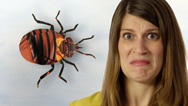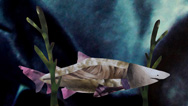Bacon Bandages Remove Botflies
- By Anna Rothschild
- Posted 06.18.15
- NOVA
Everyone loves bacon. Even parasitic maggots that live under your skin. In this episode of Gross Science, learn all about botflies and how doctors use bacon therapy to remove them.
Transcript
Bacon Bandages Remove Botflies
Posted: June 18, 2015
What has barbed hooks, lives in flesh, and can be removed with bacon? The human botfly, of course.
I’m Anna Rothschild, and this is Gross Science.
Human botflies, also called Dermatobia hominis, are insects that live in Central and South America. The adult flies live only for a few weeks—just long enough to mate and find some food for their offspring.
And where do they find their babies’ food of choice? In animal flesh. And human flesh does just fine.
To get her babies to a food source, the female bot fly latches onto a blood-sucking insect like a mosquito. Then she attaches her fertilized eggs to the mosquito’s abdomen and lets the mosquito take it from there.
When the mosquito lands on warm skin to feed, the botfly eggs hatch and the larvae dig their way in—feasting on secretions from the host’s flesh, and breathing through little air holes in their butts. If left undisturbed, they crawl out after six to twelve weeks to finish maturing on the ground.
But many people can’t wait that long. When you’re infested with a botfly larvae you have something called furuncular myiasis, and at least at the beginning it looks like a bug bite or a pimple. But as time goes on the bump gets bigger, and fluid drains from a small hole in the middle of it that the larva uses for airflow. Sometimes people can even see the larva’s tail poking out from the hole, and feel something painful moving around inside their skin, but they can’t pull it out because the maggot uses little hooks to anchor itself in place.
Fortunately, there are a few ways to extract a botfly. And believe it or not, one popular method is called bacon therapy. It’s based on a traditional Central American remedy that uses raw meat or pork fat to coax parasitic worms out of their subcutaneous homes.
A doctor lays strips of bacon over the larva’s air hole. And after a few hours, looking for air and perhaps intrigued by the delicious cured meats, the worm crawls out just enough to be yanked from the skin.
Bacon therapy is still performed today, but often the bacon is replaced by petroleum jelly, which is preferable to some patients, but arguably far less fun and delicious. Anyway, think about that the next time you bite into a nice fatty piece of bacon.
Ew.
Credits
PRODUCTION CREDITS:
- Host, Illustrator, Animator, Editor
- Anna Rothschild
- Writer, Illustrator
- Rachel Becker
- DP, Sound, Intern Extraordinaire
- Elizabeth Gillis
- Many thanks to Norm Woodley and Darvin Scott Smith.
- Celestine A
- Music Provided by APM
IMAGES
- Botfly Larva
- ©Paul Bertner
- Botfly in Skin
- The New England Journal of Medicine ©2005
SFX
- Cockroaches
- Freesound/StateAardvark
(used with permission from author) - Squeak Pack/squeak_10
- Freesound/Corsica_S
- Wink
- Freesound/Bennychico11
- Flying Mosquito
- Freesound/zywx
- Spinning Cable
- Freesound/jaredgibb
- Screen Door Opening and Closing
- Freesound/snardin42
- Produced by WGBH for PBS Digital Studios
IMAGE
- (main image: Botfly and Bacon)
- ©WGBH Educational Foundation 2015
Sources
Want more info?
Botfly biology resources:
http://bit.ly/1Lb7Boz
http://1.usa.gov/1Lb7CJ1
Smithsonian round-up article on bacon therapy:
http://bit.ly/1Lb7cCD
JAMA article on bacon therapy:
http://bit.ly/1Lb7wkA
Related Links
-

Gross Science
Bizarre stories from the slimy, smelly, creepy world of science.
-

The Mites That Live On Your Face
There are tiny mites eating, laying eggs, dying, and leaking feces on your face.
-

Herpes and the Brain
Herpes is probably hiding in your nerve cells right now.
-

When Shark Fetuses Attack
Sand tiger shark fetuses eat their siblings in the womb.

